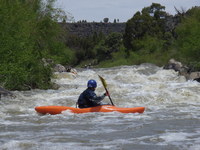
Report Highlights Bear River Restoration (ID)
The recently finalized report on a pulse flow program on the Black Canyon of the Bear River, located in Southeastern Idaho highlights the role that new water releases are playing in the restoration of the river reach. The report compared three years of baseline data collected before the water releases began, with data collected during three subsequent years during which the water releases occured. The report covers stream channel habitat, fisheries, and aquatic insects. The water releases are late spring and early summer pulse flows that were negotiated by American Whitewater and our partners between 1997 and 2003 to restore whitewater boating opportunities and ecological values to the Bear River.
The releases, which began in 2008, resulted in decreased silt and sand on the river bottom, and increased cobble and gravel. This provides increased spawning habitat for fish, and improved habitat for aquatic insects. The releases had no effect on the total density of aquatic insects, however they led to a significant increase in the three types of insects most commonly associated with cold, clear, healthy streams.
Pulse flows had no effect on the following variables, which were determined by other environmental factors: periphyton, filamentous algae, fish catch rates, fish biomass, rainbow trout relative abundance, rainbow trout catch rates, rainbow trout Condition, rainbow trout biomass, and benthic macroinvertebrate density. Pulse flows also had no effect on species richness and distribution, however there was a possible effect on redside shiners (a common minnow species).
Wind and water-related erosion result in large sediment inputs to the Black Canyon which builds up, presumably because natural flows are diverted around this section of the river. The releases scour that sediment out, mitigating the combined impacts of high sediment inputs and the hydropower diversion, but resulting in short term spikes in the turbidity of the water. The result is a healthier, more natural river, which has a better insect species assemblage and better fish habitat. It is also a recreational treasure for regional whitewater paddlers.
American Whitewater is currently working with other Bear River stakeholders to finalize the release program through monthly meetings and lots of effort in between. This report is being considered along with water quality and fish stranding data collected during releases, as well as recreational data, to create a final plan for future releases.
The report can be downloaded from the document box to the right of this article.
